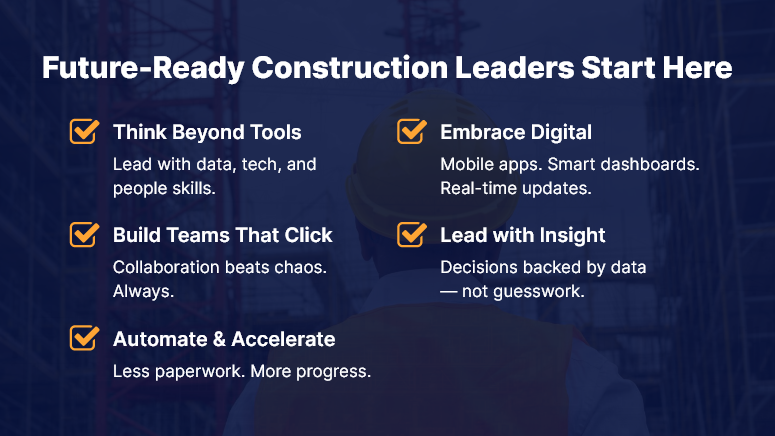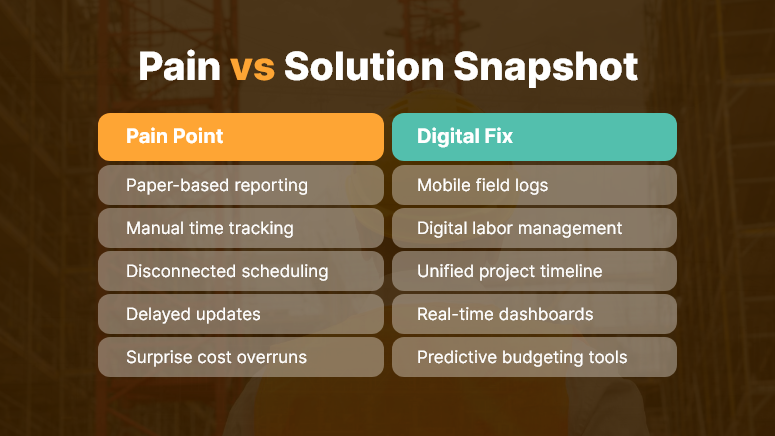Did you know the construction industry is expected to grow by over 85% by 2030, reaching $15.5 trillion globally? But while the projects get bigger, timelines shorter, and technologies smarter, leadership needs to evolve just as fast.
That’s why understanding what the next generation of construction leaders must know isn’t just important—it’s essential.
Today’s job sites demand more than experience with tools and materials. They demand digital fluency, strategic thinking, people management, and tech-enabled agility. In this blog, we’ll explore the critical capabilities tomorrow’s construction leaders must develop and how tools like OConstruction’s digital platform can prepare them for long-term success.

Business Relevance: Why Modern Leadership Matters in Construction
Traditionally, construction leaders rose through the ranks with hands-on experience and deep technical knowledge. But now, they’re expected to:
- Manage multi-million-dollar projects from mobile dashboards
- Lead cross-functional teams from the field and office simultaneously
- Analyze real-time data to make fast, informed decisions
The industry’s shift toward digital transformation, sustainable practices, and data-driven project delivery makes leadership more complex—and more critical.
Real-World Problems New Leaders Face:
- Delayed Decisions: Project managers without real-time data access are prone to making assumptions.
- Inefficient Collaboration: Manual processes create silos between field workers and back-office staff.
- Tech Resistance: Many teams struggle with new tools due to a lack of training or leadership support.
The solution? A new generation of leaders equipped with digital-first mindsets, adaptive strategies, and platforms like OConstruction to connect workflows, people, and insights.
Best Practices & Actionable Strategies for Future Construction Leaders
DO: Embrace Digital Fluency
Digital transformation isn’t optional anymore. Construction leaders must be comfortable with:
- Cloud-based platforms for document control, task tracking, and RFIs
- Mobile tools that enable remote supervision and real-time updates
- Data dashboards to identify bottlenecks and track KPIs
Tip: Familiarize yourself with tools like OConstruction’s mobile inspection module to lead efficiently from anywhere.
DON’T: Rely Solely on Gut Instinct
Great leaders balance intuition with data. That means:
- Analyzing historical project data to avoid repeating mistakes
- Using automated reports for decision-making
- Monitoring site performance through real-time dashboards
DO: Promote Cross-Team Collaboration
The best construction leaders break down communication barriers by:
- Creating centralized project hubs for real-time updates
- Standardizing communication through integrated platforms
- Scheduling recurring stand-ups across departments
Quick Win: Use OConstruction’s collaborative Gantt and task boards to align timelines across contractors and subcontractors.
DON’T: Ignore Soft Skills
Yes, tech skills are essential. But people leadership still wins projects. Focus on:
- Active listening and team engagement
- Conflict resolution during high-stress project phases
- Coaching junior staff to build an internal talent pipeline
DO: Prioritize Automation
Automation tools reduce human error and improve efficiency. Leaders must:
- Automate time logs, inspections, and compliance reporting
- Use automated workflows to manage RFIs and approvals
- Adopt smart scheduling based on labor and equipment availability
DON’T: Treat Tech as a Siloed Tool
Tools like OConstruction shouldn’t be “used”—they should be embedded into your leadership style. That means:
- Setting the example by using the platform daily
- Encouraging your team to log updates in real time
- Reviewing data trends in weekly check-ins
Customer Story: From Old School to Digital-First
For example, SkyEdge Builders, a mid-sized general contracting firm, used OConstruction’s mobile project management tools to streamline their on-site workflows. Before adopting the platform, they faced frequent delays due to miscommunication between field supervisors and project coordinators.
After implementation, SkyEdge saw:
- 30% faster approval cycles for RFIs
- 15% fewer reworks thanks to real-time inspection logs
- Improved morale due to easier task tracking and transparent timelines
Here’s how: They trained their site supervisors on mobile reporting, integrated subcontractor schedules, and used dashboard KPIs to monitor productivity weekly.
Key Takeaways: Leadership for a Digital Construction World
As the industry evolves, the construction site of tomorrow needs leaders who are digitally savvy, people-oriented, and process-driven.
Key Skills to Cultivate:
- Tech Literacy: Know how to lead through tools like OConstruction
- Data-Driven Thinking: Back up decisions with hard numbers
- Human-Centric Management: Prioritize your team’s success as much as project deadlines
- Automation Advocacy: Let machines handle the repetitive stuff so your team can focus on strategy
In summary, the next generation of construction leaders must blend timeless leadership qualities with modern digital fluency. By adopting smart platforms and continuous learning, you can drive your team toward efficiency, growth, and long-term success.


